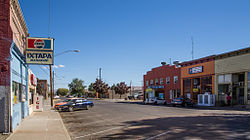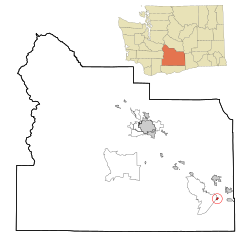2010 census
As of the 2010 census, there were 2,286 people, 528 households, and 478 families living in the city. The population density was 2,857.5 inhabitants per square mile (1,103.3/km2). There were 548 housing units at an average density of 685.0 units per square mile (264.5 units/km2). The racial makeup of the city was 46.9% White, 0.7% African American, 0.2% Native American, 0.2% Asian, 48.4% from other races, and 3.6% from two or more races. Hispanic or Latino of any race were 91.9% of the population.
There were 528 households, of which 69.1% had children under the age of 18 living with them, 55.9% were married couples living together, 25.0% had a female householder with no husband present, 9.7% had a male householder with no wife present, and 9.5% were non-families. 7.0% of all households were made up of individuals, and 3.6% had someone living alone who was 65 years of age or older. The average household size was 4.31 and the average family size was 4.41.
The median age in the city was 23.6 years. 39.4% of residents were under the age of 18; 12.5% were between the ages of 18 and 24; 25.9% were from 25 to 44; 16.5% were from 45 to 64; and 5.8% were 65 years of age or older. The gender makeup of the city was 49.0% male and 51.0% female.
2000 census
As of the 2000 census, there were 1,891 people, 445 households, and 381 families living in the city. The population density was 1,553.4 people/km2 (4,023 people/sq mi). There were 463 housing units at an average density of 380.4 units per square kilometre (985 units/sq mi). The racial makeup of the city was 21.73% White, 0.11% African American, 0.48% Native American, 1.00% Asian, 0.00% Pacific Islander, 73.88% from other races, and 2.80% from two or more races. 89.00% of the population were Hispanic or Latino of any race.
There were 445 households, out of which 60.0% had children under the age of 18 living with them, 59.3% were married couples living together, 17.3% had a woman whose husband does not live with her, and 14.2% were non-families. 12.4% of all households were made up of individuals, and 5.8% had someone living alone who was 65 years of age or older. The average household size was 4.22 and the average family size was 4.54.
In the city, the population was spread out, with 41.9% under the age of 18, 12.9% from 18 to 24, 25.8% from 25 to 44, 12.9% from 45 to 64, and 6.5% who were 65 years of age or older. The median age was 22 years. For every 100 females, there were 104.0 males. For every 100 females age 18 and over, there were 104.1 males.
The median income for a household in the city was $26,650, and the median income for a family was $26,198. Males had a median income of $18,917 versus $21,667 for females. The per capita income for the city was $7,694. 32.7% of the population and 27.9% of families were below the poverty line. Out of the total people living in poverty, 44.0% were under the age of 18 and 18.2% were 65 or older.


